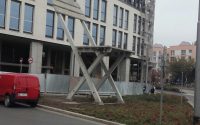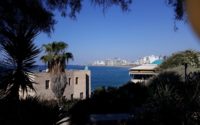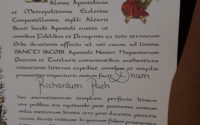From Ruins To Renewal
Beata Stankiewicz’s discovery brought my father’s story back to life. She even went herself to find the grave and also the house where my grandfather had spent the remainder of his life. With thanks, I wrote back and promised that I would visit in the near future which turned out to be two years later, in September 2017.
Still hopeful of finding information on the whereabouts of my father’s birth certificate,I decided to make the journey personally to Warsaw, but I went one step further and planned a six week trip to Germany and Poland. Evidence strongly suggests that the Pach side of my family originated in Germany, probably Bavaria and specifically from around Augsburg. Another possibility is two states, Thuringia or Saxony in the eastern part of Germany. On the 5th September 2017, I flew to Berlin. The next few weeks’ blogs, extracts from the diary I kept, are dedicated to my time in Germany and Poland.
Over the course of the 20th century, no city contributed as much to world tension as Berlin. It began the century as the capital of the German Empire or Second Reich, after WW1, it continued as the capital city of the newly created Weimar Republic until 1933 and then as the capital of the Third German Reich under the Nazis. After WW2 it was the centre of the Cold War as it divided into the free city of West Berlin a western enclave surrounded by the DDR¹ or German Democratic Republic better know as East Germany. East Berlin became the capital city of East Germany and in 1989 the unified city once again became the capital of the unified Federal republic of Germany (BRD²). A city once reduced to rubble has re-invented itself as a place that welcomes anyone.
¹ Deutsche Demokratische Republik
² Bundesrepublik Deutschland
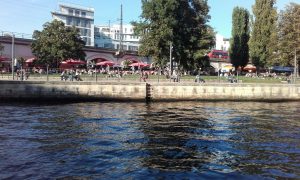
05.09.2017
I’ve finally arrived in Germany, one of the two lands of my paternal roots, the other Poland. I would like to discover if my sentiments are stronger on the continental side than the British. The next five or six weeks away are not a holiday, rather finding a sense of identity or belonging. Without a doubt, culturally, I am Scottish but any feeling of being British is ebbing away. It’s not the Britain my father adopted as his home and then acquired its citizenship, nor the one in which I was raised. I have no idea if this will take me anywhere but nor do I expect it to. Why is it that my understanding of Britishness differs so much from anyone else, even though I have never lived permanently anywhere else?
My grandfather’s family, as far as I can ascertain is of German descent. I guess they emigrated to Poland as traders or merchants or perhaps as part of an invading army and they decided to settle there. My grandmother’s side has roots in Prussia, Armenia and Hungary. A reading of the history of this part of Europe, from Germany to the Urals in Russia and from the Baltic to the Black Sea provides the answers why such a mixture should end up as loyal citizens of the Polish state while retaining their own ‘national’ characteristics.
On this my third visit to a unified Berlin, the S-Bahn takes me to Alexanderplatz Station. During the time when East Germany was a separate state the station was a crossing point between East Berlin and West Berlin. The train came to a stop there to allow East German border guards to inspect the underside of the train with mirrors attached to long poles to check for people fleeing from East Berlin to the west side. This hotel, situated in what was East Berlin sits in Karl Liebknecht Straẞe. It is a testimony to the forgotten lessons of history that the German government elected to change no street names of the straight avenues and regimented blocks and left the statues of Marx, and Engels in East Berlin intact. Leave things as they are, as the shock of the new tends not to work on a bewildered populace, that had become accustomed to the police state from 1933-1989. There has been no tangible ‘triumph of capitalism’ and you still get an impression, if you edit out of your mind the new shopping malls and bars, of what it must have been like for over forty years. Berlin is the epitome of the best attempt at democracy having shaken off the terrors of Nazism and the stranglehold of the Russian version of Marxism.
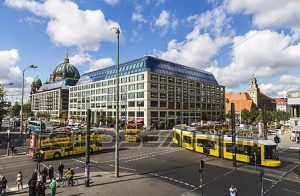
Many of my fellow British citizens do not understand the division and occupation that drives the principle of a union such as the EU. For that, I blame politicians of both major parties. Through Brexit they have foisted a negative image of Europe through rubbishing its institutions or ignoring it altogether without ever engaging to explain Europe’s raison d’être. They are stuck in their own ideologies, be it the rigid free-market tendencies of the hard right, or the unreconstructed doctrinaire socialism of the left – both bereft of any reference to the human experience. This polarisation is reminiscent of Germany in the 1930’s.
Berlin, of course, is not Germany any more than London is England, but both represent opportunity and the possibilities to be creative in diverse ways. I suppose it comes down to how both utilise these. For the former it is an on-going challenge to assimilate both halves of the city. It may never be possible, but it will never be through the want of trying.
I may have been on the Spree river tour before, I can’t remember, but this one lasted one hour and it was interesting. Steeped in tangible history that I can recall seeing on TV in the 1950’s and 60’s, and now in reality, the crosses marked on the west bank to mark where refugees from East Berlin were shot whilst attempting escape. Along the line of where the Wall was, you cannot differentiate where the boundary ran, as the affluence of the West has inundated that part of the East. The ghosts however, remain.
The view all round the city is best viewed in the late evening and night from the Fernsehturm (TV Tower) in what was East Berlin. You can hardly feel the movement of the revolving restaurant in a structure which was also used as a propaganda exercise against the west by the Stasi.
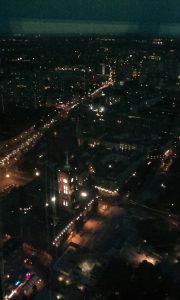
06.09.2017
The forecast today is for rain, but that matters not as there’s plenty to do in Berlin whatever the weather. Berliner Unterwelten (Underworld) will keep me out of the rain – and to get there will mean my first ride on a Berlin tram. I should have known better than try to pay with a €50 note. Would I ever consider paying a bus fare with a £50 note? The exchange rate is almost one to one.
There are three tours and I have elected to take the Dark World one, which takes the visitor to the WW2 bunkers and depending on how it goes I might do the one about the Cold War before I leave Berlin.
The tour is hugely informative. I know all about the London Blitz and all about the people who survived it; the horrors and the spiritedness. I know mostly about what happened during the Nazi occupation of Europe; the atrocities in the East, the Holocaust, the aftermath of the war all over Europe including Germany, the concentration camps and all the rest. It’s all factual, but it doesn’t tell the whole story, because the Germans’ story of life during the air raids has gone mostly unpublished outside of Germany. All that remained, whether because of a reluctance to talk, was anecdotal evidence. The tunnels were locked up and forgotten about until someone decided to look behind a steel door and was amazed at what they discovered, and so decided to explore further. The result was that, a section of the tunnel system had been used as a shelter during air raids. Today, for the first time I’ll learn some of the history of Berlin’s tunnel system, and particularly how it was adapted after August 1940, when the RAF commenced bombing raids on German cities, especially Berlin. They were never to serve as bomb shelters such was the Nazi regime’s confidence that Berlin would never be bombed. The result was a hastily decreed directive from Hitler personally to proceed with the work. Originally, the tunnels were a gap between the U-bahn system and the ground level outside, but in the 1920’s, the city council decided to utilise the space by building messing quarters for the transport system employees. Two years after Hitler came to power in 1933, he urged the creation of a civilian force of shelter builders to help the populace build their own shelters. As National Socialism required citizens to join civil organisations, this was an outlet for those who did not wish to join the Nazi party to fulfill the regimes’ requirement. In Hitler’s mind, he was preparing the country for the war he was determined to start by creating an idea of Germany, surrounded by enemies, ready to invade anytime.
You are transported back in your imagination to the 1940’s – even some of the signage terminology is redundant, ‘Zum Frauen Abort’ (To the Women’s Toilet ) and ‘Zum Männer Abort’ (To the Men’s Toilet ) are two examples where the word ‘Abort’ means toilet. The toilets themselves are waterless. A handle like a brake was pulled up which allowed topsoil in the cistern to pour on top of the defecation; this was done repeatedly until full when it was emptied and recycled as fuel. Certain rooms have luminous paint on the walls, so that if there was a power failure, the paint would have absorbed enough from the light bulbs to glow for a while. Doorways and steps are similarly treated. Other facts I learned; this particular shelter was intended to provide cover for 1,000 people but in fact 5,000 crammed in as the war reached its climax; unlike the London blitz, and due to the Nazi race laws only Aryan people were allowed in. This meant that carrying official documents were as important as bringing water below. The guide also pointed out that the walls were 80cm thick of reinforced concrete, whereas a bomb proof shelter required walls to be 2m thick to have the best chance of withstanding a bomb blast.
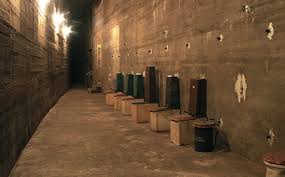
One piece of irony that made me laugh was, and there are photographs on the walls, that after the war and during the programme to de-militarise Germany, the Allies tried to blow up the bomb shelters with little success, as they remained largely intact which proved their worth. They did not retain them, having to demolish them by other means, as the Allies wished to eliminate all vestiges of the German military.
One interesting point; there are numerous hills in the Berlin parks. These are formed from the rubble that was gathered up during the cleanup process after the war, and then landscaped.
07.09.2017
One thing that united the Prussian/German royalty with their English cousins was a love of lavish palaces. The Prussian kings and then the German Kaisers located theirs in Potsdam, which today is the capital of the state of Brandenburg.
I remember when I was 18 on a train journey from Warsaw to Hoek van Holland which traversed East Germany. The train passed along the same line I’m on just now as I make my way to Potsdam. I remember the border crossing between West Germany and East Germany at Marienborn with the East German border guards and the Russian soldiers, then between East Germany and West Berlin, between West Berlin and East Berlin and then between East Germany and Poland. My passport had been stamped four times along the way, and the same rigmarole on the way back. How times change – back then I had never imagined that one day all of that would be just a memory. Now I’m getting off at Potsdam and instead of border guards, it’s tour guides advertising the numerous bus tours around Potsdam and the palaces; primarily for the latter.
The only thought that Potsdam ever evoked for me was of the conference in 1945 where Stalin, Truman and Churchill met to thrash out the future of Germany (and with any luck not each other, because by then east-west tensions had already escalated). Churchill had brought Attlee, as leader of the Labour opposition, along as well, because campaigning for the British General Election was in progress and technically there was no British government. Attlee later assumed the sole representation for Britain as Prime Minister. Doesn’t it say something about our ignorance of the points of European history that don’t involve Britain in a war that until very recently I can only remember vague references to Kaiser Wilhelm II in relation to Potsdam. I had no idea of the importance of Potsdam in German, but particularly Prussian history. As such, I had imagined it more as a suburb of Berlin than a city in its own right, separated from Berlin by the Glienicke Bridge that crosses the river Havel. This crossing would have been the border with West Berlin during the Cold War. The green paint on the bridge is lighter on the east side and, the white line marking the old border is still visible. Potsdam has 130,000 inhabitants today and it appears to be quite an agreeable place with an eclectic mixture of German, neo-Classical (heavily influenced by the Prussian Kings) Dutch, French and English style buildings reflecting the artisans, traders and craftsmen invited there by successive Prussian monarchs. The city has numerous buildings that would have served the military as Prussia was a de facto military state. After WW2,the Russians continued to use the city as a military garrison. I cannot imagine what the city was like in the days of East Germany, as there has been what appears to be extensive re-development, but there are still vestiges of the spartan drab nature of the buildings erected during the communist era. As the USSR had been dissolved in 1991, the last Russian troops left by agreement in 1994. The KGB also utilised many properties surrounded by high walls and metal fencing, and one building was used as a listening post for espionage purposes.

Although the city was first mentioned in chronicles as a fishing settlement in the 10th century under the name Potztupimi, it was under Frederick the Great, the warrior king, that it finally blossomed as the seat of government of the Prussian state and was expanded by successive Prussian kings and the German emperors. I cannot exactly recall the names of the palaces, but the entire project across two centuries was gargantuan. The city was the real seat of government of the Second Reich until 1918, when Kaiser Wilhelm II was forced to abdicate just before the Armistice that ended WW1. He died in exile in Holland in 1941, leaving explicit instructions that his remains were not to be repatriated to Germany until the monarchy was restored.
One last mention of the Potsdam Conference of 1945; this was convened in the Cecilienhof, a grand mock-Tudor house. The outcome of the conference is well known, but a lesser detail, and one that could have scuppered or delayed the entire conference, occurred or at least would have created a major diplomatic incident and also one that Jonathan Swift would certainly have appreciated. The organisers of the conference (event managers today) had to create three entrances, as to have had anyone of the three Allied leaders ahead of the other two might have construed an impression of seniority in the eyes of the world, as this was on the newsreels in cinemas worldwide. This would have created a diplomatic incident. If that had happened I imagined to myself the three leaders, behind closed doors, slapping each other like overgrown schoolkids!
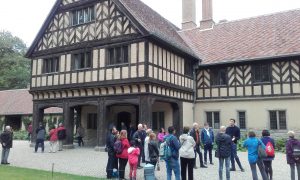
Although East Berlin’s buildings are generally of the architecture-free monolith type associated with communism, there are some grand old buildings with splendid facades around Prenzlauer Berg, where my nephew, John Lightbody, lives, and also an interesting concept in bars. John explains that The Weinerei Forum has wines on offer that you can try and also food but, usually with only two dishes on offer (so informal, it doesn’t matter) with the proviso that you pay what you think is fair at the end. I must say that the money bucket was bulging, so perhaps they are on a winner in the short term. Many students and young professional people hang out here.
08.09.2017
From the creativity of Potsdam to the banality of the communist era, such was the stifling oppressiveness of the regime kept in power by the Stasi. If there are still any apologists for the Stasi or nostalgia for the East German regime, they should visit the Stasi Museum.. There is no book of rules that says socialism has to equate with boring functionality and a ponderous bureaucracy – its buildings, its activities, its decor and the stony demeanour of the people who worked for it. Is it any wonder some the citizens fled or were killed trying or some who committed suicide. The policing of thought must be one of the worst crimes that could be committed against humanity. It is as heinous as the worst excesses of the capitalist system.
The money that must have been wasted running this organisation with nothing to contribute to the country’s economy; the thousands of personnel official and unofficial; its vast crushing bureaucracy and the paperwork must have had the capacity to fill several oil tankers. The interior decor is brown – with a vengeance – its carpets, its furniture. I would have gone mad long ago working here. I felt queasy and disgusted at the end of it. I needed a coffee but I couldn’t bear at that moment to look at anything else brown. As one with a socialist heart, I feel nauseous at the way they and the rest of the secret police organisations of the former Warsaw Pact countries treated their citizens.
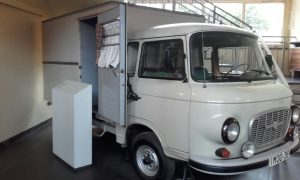
Now a step into the creative environment of the Bauhaus Archive. The last time we visited Germany we stopped over for the evening in Weimar and we (or maybe I) visited the Bauhaus Museum. I wanted to see what the exhibits were at this one in Berlin. Old photographs and some original drawings from some of the leading lights of the Bauhaus Movement. The turbulent short history of the Bauhaus replicates the turbulence taking place in Germany in the first part of the 20th century. It is pockmarked with infighting among the leading Bauhaus participants themselves, the Wall Street crash and its effect on Germany, political interference and finally closure by the Nazis. The Bauhaus philosophy was always apolitical; to merge the arts and crafts and to explore the possibilities of integrating these to the technological advances of the day effectively, helping to create an environment where goods and decent housing would be accessible to all – by simplifying household objects that could be mass produced efficiently. Its proponents also taught as well as designed. I’m guessing that it might have been a reaction to elitism of Empire. The Bauhaus era spanned the Russian Revolution with the spread of Bolshevism as a form of socialism, WW1 right through to Hitler’s election as German Chancellor. I guess it was viewed as political by its right-wing enemies eager for the introduction of ideologically pure art such as the neo-Classical monstrosities that the Nazis wanted to foist on the nation. Written testimonies to the movements aims are exhibited with contributions from Walter Gropius, Paul Klee and Hans Mayer. How ironic though, that the communist Stasi might have regarded the Bauhaus Movement with the same hostility.
What has this visit in Berlin to do with family history? Probably not very much but it’s important to know that what happens in Berlin often has a direct effect on Poland, where I head to tomorrow.
End
